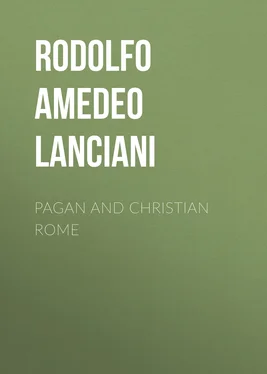Rodolfo Amedeo Lanciani - Pagan and Christian Rome
Здесь есть возможность читать онлайн «Rodolfo Amedeo Lanciani - Pagan and Christian Rome» — ознакомительный отрывок электронной книги совершенно бесплатно, а после прочтения отрывка купить полную версию. В некоторых случаях можно слушать аудио, скачать через торрент в формате fb2 и присутствует краткое содержание. Жанр: foreign_edu, История, История, на английском языке. Описание произведения, (предисловие) а так же отзывы посетителей доступны на портале библиотеки ЛибКат.
- Название:Pagan and Christian Rome
- Автор:
- Жанр:
- Год:неизвестен
- ISBN:нет данных
- Рейтинг книги:3 / 5. Голосов: 1
-
Избранное:Добавить в избранное
- Отзывы:
-
Ваша оценка:
- 60
- 1
- 2
- 3
- 4
- 5
Pagan and Christian Rome: краткое содержание, описание и аннотация
Предлагаем к чтению аннотацию, описание, краткое содержание или предисловие (зависит от того, что написал сам автор книги «Pagan and Christian Rome»). Если вы не нашли необходимую информацию о книге — напишите в комментариях, мы постараемся отыскать её.
Pagan and Christian Rome — читать онлайн ознакомительный отрывок
Ниже представлен текст книги, разбитый по страницам. Система сохранения места последней прочитанной страницы, позволяет с удобством читать онлайн бесплатно книгу «Pagan and Christian Rome», без необходимости каждый раз заново искать на чём Вы остановились. Поставьте закладку, и сможете в любой момент перейти на страницу, на которой закончили чтение.
Интервал:
Закладка:
The Manii Acilii Glabriones attained celebrity in the sixth century of Rome, when Acilius Glabrio, consul in 563 (b. c. 191), conquered the Macedonians at the battle of Thermopylai. We have in Rome two records of his career: the Temple of Piety, erected by him on the west side of the Forum Olitorium, now transformed into the church of S. Nicola in Carcere; and the pedestal of the equestrian statue, of gilt bronze, offered to him by his son, the first of its kind ever seen in Italy, which was discovered by Valadier in 1808, at the foot of the steps of the temple, and buried again. Towards the end of the republic we find them established on the Pincian Hill, where they had built a palace and laid out gardens which extended at least from the convent of the Trinità dei Monti to the Villa Borghese. 3 3 See Ersilia Lovatelli: Il Monte Pincio , in the Miscellanea archeologica , p. 211.—Rodolfo Lanciani: Su gli orti degli Acili sul Pincio , in the Bullettino di corrispondenza archeologica , 1868, p. 132.
The family had grown so rapidly to honor, splendor, and wealth, that Pertinax, in the memorable sitting of the Senate in which he was elected emperor, proclaimed them the noblest race in the world.
The Glabrio best known in the history of the first century is Manius Acilius, who was consul with Trajan, a. d. 91. He was put to death by Domitian in the year 95, as related by Suetonius ( Domit . 10): "He caused several senators and ex-consuls to be executed on the charge of their conspiring against the empire,— quasi molitores rerum novarum ,—among them Civica Cerealis, governor of Asia, Salvidienus Orfitus, and Acilius Glabrio, who had previously been banished from Rome."
The expression molitores rerum novarum has a political meaning in the case of Cerealis and Orfitus, both staunch pagans, and a religious and political one in the case of Glabrio, a convert to the Christian faith, called nova superstitio by Suetonius and Tacitus. Other details of Glabrio's fate are given by Dion Cassius, Juvenal, and Fronto. We are told by these authors that during his consulship, a. d. 91, and before his banishment, he was compelled by Domitian to fight against a lion and two bears in the amphitheatre adjoining the emperor's villa at Albanum. The event created such an impression in Rome, and its memory lasted so long that, half a century later, we find it given by Fronto as a subject for a rhetorical composition to his pupil Marcus Aurelius. The amphitheatre is still in existence, and was excavated in 1887. Like the one at Tusculum, it is partly hollowed out of the rocky side of the mountain, partly built of stone and rubble work. It well deserves a visit from the student and the tourist, on account of its historical associations, and of the admirable view which its ruins command of the vine-clad slopes of Albano and Castel Savello, the wooded plains of Ardea and Lavinium, the coast of the Tyrrhenian, and the islands of Pontia and Pandataria.
Xiphilinus states that, in the year 95, some members of the imperial family were condemned by Domitian on the charge of atheism, together with other leading personages who had embraced "the customs and persuasion of the Jews," that is, the Christian faith. Manius Acilius Glabrio, the ex-consul, was implicated in the same trial, and condemned on the same indictment with the others. Among these the historian mentions Clemens and Domitilla, who were manifestly Christians. One particular of the case, related by Juvenal, confirms the account of Xiphilinus. He says that in order to mitigate the wrath of the emperor and avoid a catastrophe, Acilius Glabrio, after fighting the wild beasts at Albanum, assumed an air of stupidity. In this alleged stupidity it is easy to recognize the prejudice so common among the pagans, to whom the Christians' retirement from the joys of the world, their contempt of public honors, and their modest behavior appeared as contemptissima inertia , most despicable laziness. This is the very phrase used by Suetonius in speaking of Flavius Clemens, who was murdered by Domitian ex tenuissima suspicione , on a very slight suspicion of his faith.

Map of the Via Salaria.
Glabrio was put to death in his place of exile, the name of which is not known. His end helped, no doubt, the propagation of the gospel among his relatives and descendants, as well as among the servants and freedmen of the house, as shown by the noble sarcophagi and the humbler loculi found in such numbers in the crypt of the Catacombs of Priscilla. The small oratory at the southern end of the crypt seems to have been consecrated exclusively to the memory of its first occupant, the ex-consul. The date and the circumstances connected with the translation of his relics from the place of banishment to Rome are not known.
Both the chapel and the crypt were found in a state of devastation hardly credible, as though the plunderers had taken pleasure in satisfying their vandalic instincts to the utmost. Each of the sarcophagi was broken into a hundred pieces; the mosaics of the walls and ceiling had been wrenched from their sockets, cube by cube, the marble incrustations torn off, the altar dismantled, the bones dispersed.
When did this wholesale destruction take place? In times much nearer ours than the reader may imagine. I have been able to ascertain the date, with the help of an anecdote related by Pietro Sante Bartoli in § 144 of his archæological memoirs: "Excavations were made under Innocent X. (1634-1655), and Clement IX. (1667-1670), in the Monte delle Gioie, on the Via Salaria, with the hope of discovering a certain hidden treasure. The hope was frustrated; but, deep in the bowels of the mound, some crypts were found, encrusted with white stucco, and remarkable for their neatness and preservation. I have heard from trustworthy men that the place is haunted by spirits, as is proved by what happened to them not many months ago. While assembled on the Monte delle Gioie for a picnic, the conversation turned upon the ghosts who haunted the crypt below, when suddenly the carriage which had brought them there, pushed by invisible hands, began to roll down the slope of the hill, and was ultimately precipitated into the river Anio at its base. Several oxen had to be used to haul the vehicle out of the stream. This happened to Tabarrino, butcher at S. Eustachio, and to his brothers living in the Via Due Macelli, whose faces still bear marks of the great terror experienced that day."
There is no doubt that the anecdote refers to the tomb of the Acilii Glabriones, which is cut under the Monte delle Gioie, and is the only one in the Catacombs of Priscilla remarkable for a coating of white stucco. Its destruction, therefore, took place under Clement IX., and was the work of treasure-hunters. And the very nature of clandestine excavations, which are the work of malicious, ignorant, and suspicious persons, explains the reason why no mention of the discovery was made to contemporary archæologists, and the pleasure of re-discovering the secret of the Acilii Glabriones was reserved for us.
These are by no means the only patricians of high standing whose names have come to light from the depths of the catacombs. Tacitus ( Annal . xiii. 32) tells how Pomponia Græcina, wife of Plautius, the conqueror of Britain, was accused of "foreign superstition," tried by her husband, and acquitted. These words long since gave rise to a conjecture that Pomponia Græcina was a Christian, and recent discoveries put it beyond doubt. An inscription bearing the name of ΠΟΜΠΟΝΙΟC ΓΡΗΚΕΙΝΟC has been found in the Cemetery of Callixtus, together with other records of the Pomponii Attici and Bassi. Some scholars think that Græcina, the wife of the conqueror of Britain, is no other than Lucina, the Christian matron who interred her brethren in Christ in her own property, at the second milestone of the Appian Way.
Читать дальшеИнтервал:
Закладка:
Похожие книги на «Pagan and Christian Rome»
Представляем Вашему вниманию похожие книги на «Pagan and Christian Rome» списком для выбора. Мы отобрали схожую по названию и смыслу литературу в надежде предоставить читателям больше вариантов отыскать новые, интересные, ещё непрочитанные произведения.
Обсуждение, отзывы о книге «Pagan and Christian Rome» и просто собственные мнения читателей. Оставьте ваши комментарии, напишите, что Вы думаете о произведении, его смысле или главных героях. Укажите что конкретно понравилось, а что нет, и почему Вы так считаете.












